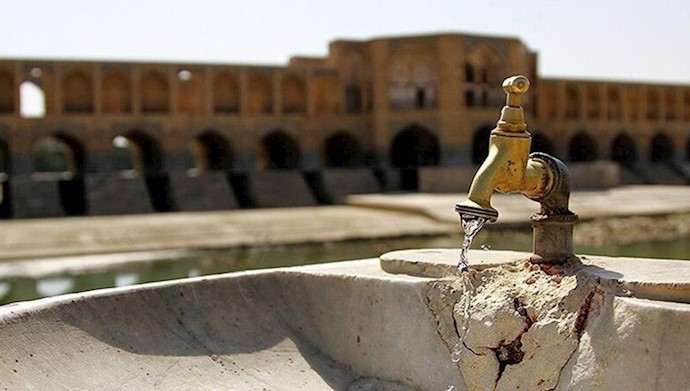Analysis by PMOI/MEK
Iran, July 17, 2019 – A member of the Iranian regime’s Majlis (parliament) acknowledged the water shortage crisis in Isfahan province.
“Regarding potable water, parts of Isfahan province lack potable water as we speak. I say to you members of this majlis, you Mr. Mesri and all of you brothers and sisters who are sitting here, be informed: During the past couple of weeks that we went to our constituency, we saw many cities in Isfahan province experience water cut off more than ten hours a day. Our Shahin-Shahr was the same, Gorgab also the same and other parts as well,” said Haji Deligani, a Majlis member from Isfahan, during an open session of the parliament.
He went on to say that the situation is the same in Isfahan, a major city in central Iran, where locals lack water for hours. Such conditions are unbearable, especially when temperatures hit above 40 degrees Celsius.
The water crisis has expanded to such an extent in Isfahan that even the Friday prayer Imam of Isfahan had to confess to the problem.
“The demise of Isfahan is through the water. This is not just some talks. It is real life. If we cannot supply water to Isfahan, we will face drastic consequences,” Yousef Tabatabaie said.
Read more:
In recent years, the water shortage crisis has hit many areas of Iran, leaving large swaths of the population suffering. Especially thousands of small villages are hit hard and have virtually become empty as residents have moved to the outskirts of urban cities and are now living in slums. According to reports, even some cities in northern Iran, where water has always been plenty, are suffering from the crisis.
On June 26, Zayandeh-rud, the largest river of the Iranian Plateau in central Iran, went dry from around Flavarjan county. Local farmers of Isfahan protested, saying that “Zayandeh-rud’s water right is our inalienable right,” in reference to the motto of the Iranian regime for its nuclear program that says “Atomic energy is our inalienable right.”
On Jun 29, an Iranian citizen posted a video about the situation of drinking water in his village in Shush county that went viral on social media.
“People say that the water of this village has been tested and [authorities] say there is no problem. This video, however, shows that there are living creatures with big bodies in the water, proving the tests wrong,” the citizen reporter says in the video.
In another video from June 27, making rounds on social media, a resident of Isfahan’s Shahin Shahr says: “In recent days, frequent water outages in Pardis, Milad, Mahdie Square and Hasht Behesht districts of Shahin Sahr in Isfahan Province have pushed locals to their limits.”
“In these districts, there is no water until 1 pm every day,” the video further says.
Isfahan’s water and sewage company explain that the reason for the frequent water outages is that “Drinking water consumption by the people in the province is 14 cubic meters per second, while the main water treatment facility can produce 12.8 cubic meters [of potable water] per second.”
Even northern Iranian cities are hit by the water crisis.
In Mazandaran province, locals in the town of Salman Shahr bordering the Caspian sea are witnessing such unclean water that the citizens practically cannot drink it.
According to a report published in March by state-run ISNA news agency, the problem of the people in Mazandaran Province is not just about potable water but water for agricultural purposes is also scarce.
Mohammad Darvish, an environment activist, says that worn-out industrial facilities consume such large amounts of water that the commodity has become scarce, especially in central Iran.
According to Darvish, the Iranian steel industry uses around 1,000 cubic meters of water per hour to decrease its steel temperature from 450 degrees Celsius to 50. “While in [other parts of] the world, this process consumes only 10 cubic meters of water, not a thousand. This means that we are facing a dysfunctional industry that is severely behind current technology,” he added.
Iranian officials continuously try to blame drought for the water scarcity problem but Darvish argues that according to the regime’s own Energy Ministry, about 50 billion cubic meters of water can be stored behind dams all over Iran. They also say we are facing a 40 percent drought.
“Assuming that this 40 percent does not change, we must have an average 60 percent of water (30 billion cubic meters) stored behind dams. The drinking water needed by Iranian citizens is eight billion cubic meters. This means that in the worst-case scenario, we would have 22 billion cubic meters of excess water behind our dams,” he explained.
“A sizable portion of the people’s drinking water is covered through other means such as groundwater and seawater treatment equipment on the Persian Gulf and Gulf of Oman beaches. It’s not imaginable in any way that we will witness a water rationing crisis for Iranians,” he further said in his interview with the state-run ISNA news agency in February.
Darvish went on to say that the current rationing “has nothing to do with natural and regional constraints, but shows that we have acted in poor fashion in placing the dams and managing water resources, destroying our assets and capital as a result.”





